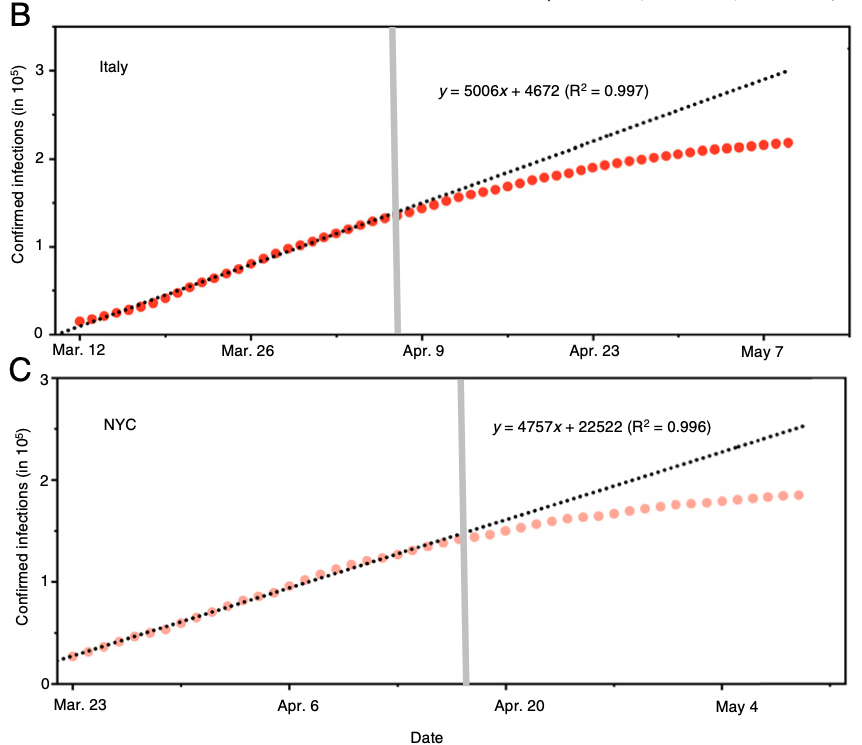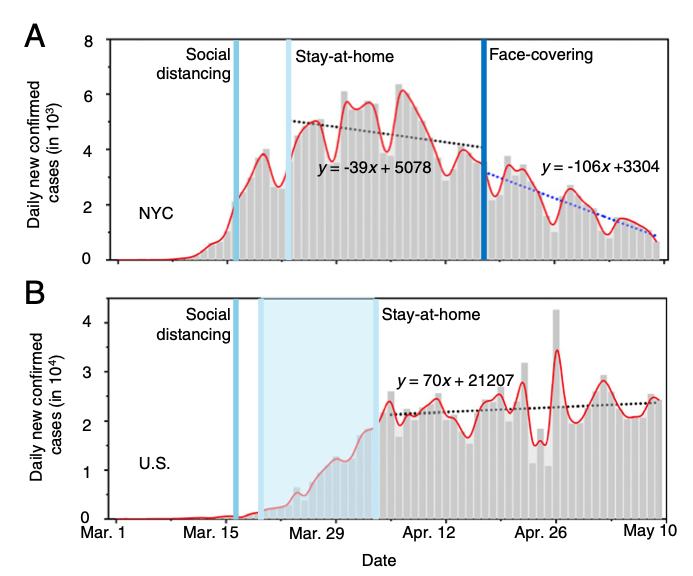Mask Wearing Correlates Strongly with Declining COVID-19 Transmission, Says New Study
Airborne transmission is the dominant route for the spread of COVID-19.

Wearing face masks in public is the most effective way to prevent the transmission of the coronavirus that causes COVID-19, according to a new study in the Proceedings of the National Academy of Sciences. The researchers also conclude that airborne transmission is the dominant route for the disease's spread.
The team of chemists and atmospheric scientists behind the report came to this conclusion by tracking how the epidemics unfurled in three epicenters—Wuhan, China; northern Italy; and New York City—before and after mandatory masking was adopted. Keeping in mind that correlation does not necessarily mean causation, let's look at what they report.
The researchers analyze the epidemic's trend and the mitigation measures in the three epicenters from January 23 to May 9. In their analysis, they take into account the timing of when stay-at-home guidelines, social distancing recommendations (such as limits on crowd sizes), lockdown measures (such as the closing of schools, restaurants, and sporting events), instructions to wash hands frequently, and mandatory public masking were adopted in each region. They then correlate these measures with the observed trends in confirmed COVID-19 cases in each jurisdiction.
Chinese authorities in Wuhan basically adopted social distancing, crowd limits, lockdowns, and masking simultaneously in late January. Lockdown and social distancing measures were adopted on March 9 in Northern Italy and on March 22 in New York City. Public masking was mandated in northern Italy on April 6 and for the rest of the country on May 4; in New York City, the face mask mandate came on April 17.
The researchers quantified the effects of face covering by projecting the number of infections based on the data prior to implementing the use of face masks in northern Italy on April 6 and New York City on April 17:

They calculate that mandated masking reduced the number of confirmed cases by more than 78,000 in Italy from April 6 to May 9 and by more than 66,000 in New York City from April 17 to May 9. On May 9, there had been about 220,000 confirmed COVID-19 cases in Italy and around 185,000 in New York City.
The team also compares the trend in the number of cases in masked New York City from April 17 to May versus the rest of the country from April 5 to May 9. They find that after mandatory masking, COVID-19 cases in New York City began declining at the rate of about 3 percent per day, whereas they continued to rise in the rest of the country at around 0.3 percent per day. "The decreasing rate in the daily new infections in NYC with mandated face covering is in sharp contrast to that in the United States with only social-distancing and stay-at-home measures, further confirming the importance of face covering in intervening the virus transmission," the authors argue.

The researchers review prior studies on how many respiratory particles infected people shed and how long those aerosols linger the the air, both indoors and outdoors. They note that the initial public health advice—e.g., frequent hand-washing—was largely aimed at preventing the disease from spread through direct contact, such as touching surfaces contaminated with the virus. And those are still good recommendations. But while following that advice slowed the epidemic, dramatic reductions in viral transmission in Italy and New York City occurred only after wearing masks in public was mandated. They therefore conclude that masking prevents the transmission of the disease by blocking the atomization of virus-containing respiratory droplets (coughing, sneezing, talking) and their subsequent inhalation by uninfected people.
Since they find that airborne transmission is the dominant route for spreading COVID-19, they argue that "wearing of face masks in public corresponds to the most effective means to prevent interhuman transmission, and this inexpensive practice, in conjunction with extensive testing, quarantine, and contact tracking, poses the most probable fighting opportunity to stop the COVID-19 pandemic, prior to the development of a vaccine."
Correlation, again, is not causation. But this is a pretty strong correlation.
